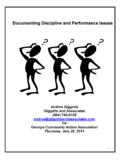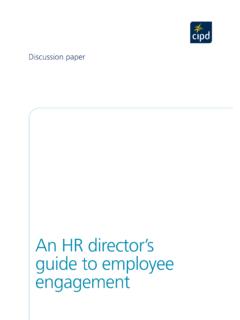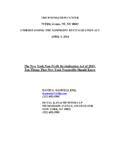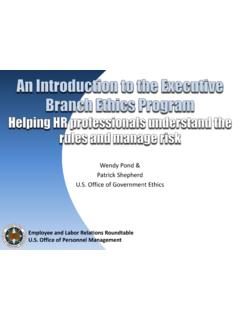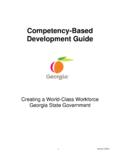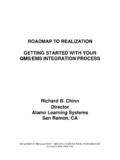Transcription of The Labor Shortage - Smiklespeaks
1 Even if you did not believe the doom-sayers of the past few years, if you havepositions to fill, you know that there wastruth in their predictions. In a 2004 study con-ducted in partnership with the EmploymentPolicy Foundation, consulting firm WatsonWyatt concluded that the Labor Shortage in theUnited States could reach million workersin 2020. This is due, in part, to the aging popula-tion. The Bureau of Labor Statistics estimatesthat, from 2005 to 2012, the annual growth rateof the 55 and older population will be fourtimes greater than that of the overall workforce. This Labor Shortage , while still in its earlyyears, presents several problems foremployers, particularly small businesses. Weoperate on smaller profit margins than huge,multi-national corporations. Our recruitingresources are limited. Many small businesses rely on news-paper ads and the occasional online posting for new employers have the ability to take regular advantage ofcareer fairs, far-flung Web-based advertising and any numberof other outreach efforts aimed at getting the best talent avail-able.
2 The other disadvantage that small employers often faceis that there are fewer people doing the work. This takes multi-tasking to the highest level. In most dealerships, it is notuncommon for people to occupy double roles; the officemanager may double as the HR representative and the CFOmay also manage employee benefits. Staffing ChallengesThe fact of the matter is that there do not seem to beenough well-qualified people for the positions. Managersacross the country are lamenting their inability to get andkeep the best people. Whether you own the dealership or aremanaging a department, you have undoubtedly felt the effectsof the Labor Shortage firsthand not enough applicants, littleor no loyalty from new employees and perhaps a sense of enti-tlement from older staff members. These are persistent com-plaints from managers struggling with the effects of theshortage of competent, committed should first be noted that an unfilled position is betterthan a poorly filled position.
3 It is far wiser to be selective inhiring than to hire the first warm, breathing body you find. Thework that it takes to deal with an incompetent, uncooperativeor uncommitted employee is more taxing than waiting for theright person. Think about the amount of effort that managersput into bad hires. Not only do these employees create extrawork for managers, they also often make life difficult for therest of the team. Their colleagues are forced to suffer throughthe pain of working with a person ill-equipped for the members are called upon to fix and fill-in for these badhires. In extreme cases, good employees will leave because ofthe extra burden brought on because they are overworked staffing problems are real and trying for even themost savvy leaders. But they are not insurmountable. JohnKuchta, president of Omaha, Solution One, uses athorough approach to finding the right people.
4 He believes thatone bad employee can cost you a customer that you have hadfor many years. Rather than risk a customer defection, Kuchtauses a well-planned approach to hiring. He makes sure that themessage is clear they will not settle for just a warm body. Hehas high standards and a tough screening process, but neitherThe Labor ShortageA smart manager s guide to keeping good peopleby: Joanne Smikle, Smikle Training Services ISSUES recruitment nor retention are problems forhis company. Kuchta attributes this to thefact that his company uses a detailedprocess on the front-end. His processbegins with a screening interview and anassessment. The results are measuredagainst the job description. The subsequentinterview is typically three hours long. Itallows the candidate to get to know thecompany and vice versa. Each and everyhiring manager is trained for the screening process.
5 Kuchtaapproves every hire and is active in the recruitment process. Catching & Keeping the Right PeopleRecognizing the fact that there are fewer well-qualified peoplefor jobs in many regions of the country, it is necessary for man-agers to implement smart recruitment and retention your approach to getting and keeping good peoplewill enable you to feel less of the pain of the Labor are five strategies that, when consistently implemented,will enable you to skillfully staff your #1: Look where you have never looked before If youtypically hire from the newspaper or the Internet, considerunusual places. This new terrain can include local graduateschools. Masters programs draw mid-career professionals,many of whom may be looking for the next challenge. It is sur-prising how many people enter graduate programs with thehope of making a career transition.
6 This is the prime locationfor finding your next the population is aging, it makes sense to hire olderpeople. The Grey Brigade comes with experience and a strongwork ethic. While you may think that everyone over 60 is lookingfor a Florida retirement, many within that population are optingto stay in the workforce. We are living longer and healthier lives,so there are fewer reasons to reach for the rocking chair on your60th birthday. Contact AARP, local senior centers and your localgovernment s office of aging to seek out #2: Offer seasonal opportunities If your businessexperiences predictable peaks, plan to use seasonal employeesto fill those positions. Rethink your business model to deter-mine where and how you can use limited-term workers to fillgaps in your current staffing. Consider which projects lendthemselves to seasonal workers. Perhaps it is order fulfillmentthat is consuming too much time.
7 Or, it may be managingmajor mailings and marketing campaigns. Once you identifyprojects that lend themselves to seasonal or temporaryemployees, begin advertising in community newspapers. Yes,the major newspapers in your metropolitan area can yieldleads, but community papers are oftenread by people looking for part-time andshort-term #3: Flexibility Keeping yourbest employees requires flexibility. Eachbusiness defines flexibility differently. Insome companies it will mean creating flex-ible work schedules to accommodate theneeds of part-time employees. In otherorganizations, flexibility may be defined asjob sharing between two part-time employees. And yet, in otherorganizations, flexibility may mean allowing telecommuting forappropriate positions. Ask your employees to find out where youcould become more flexible and is especially important if you are going to utilizethe talents of semi-retired seniors or stay-at-home have built full lives and will work if the work can meldwith their existing commitments.
8 It is important foremployers to develop sensitivity to these needs. Whenemployees see that you are willing to work with them, they willwork with you. You will engender commitment by being rea-sonable and #4: Create a welcoming workplace If you intend tokeep solid new and old employees, you must give serious consid-eration to your organizational culture. Is your workplace onewhere people want to work? Is your lunchroom bright andpleasant? Do you make small gestures like providing snacks in thebreak room? Welcoming workplaces are celebratory environ-ments where people are the focus. Birthdays and other significantevents should be remembered and acknowledged formally orinformally. These are the small things that have big payoffs. Whenpeople know that their managers care about them and their lives,they are more willing to invest in the work and the workplaces are characterized by open commu-nication that flows up and down.
9 Employees want to be ableto voice their suggestions, bright ideas and concerns. Compa-nies that have regular staff meetings where employees havetime to question, discuss and share are typically more suc-cessful than those that do not. These companies emphasizewhat is most important listening and learning from thepeople who do the #5: Coach and mentor Coaching and mentoringare performance management tools that should be used with allemployees, new or old. Use these tools with new employees toget them in sync with the work and the workplace. Assign amentor to new hires to help them learn about the job, theindustry and the company. Making people feel welcome extendsto providing them with a mentor as soon as they come on boardWelcoming workplacesare characterized byopen communication that flows up and down. Employees wantto be able to voice their suggestions.
10 And using this mentoring system immedi-ately connects new hires to the have an instant support system thatthey can turn to with questions and con-cerns. This is a simple retention strategythat keeps human connections growing inthe helps employees, regardlessof their tenure with the company, to reachtheir fullest potential. It cannot beassumed that managers know how to coach most need tobe taught. The DRAW Model is an easy-to-use approach. Thefirst step, Distinguish & Define, focuses on creating clarityabout the relationship. In this step, the coach identifies who will be coached andwhy. Coaching should be used to reinforce positive behaviorand correct negative behavior. In the second step, Relate & Route, the employee and his(or her) coaching mentor begin to build bridges with oneanother. Creating a human connection is vital to successfulcoaching relationships.
